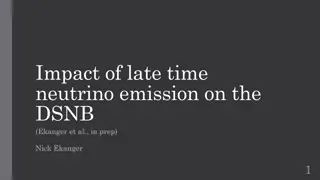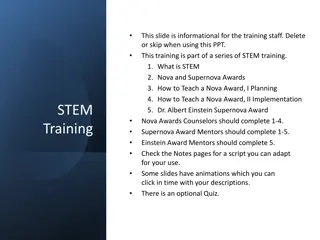STEM Training Series for Nova and Supernova Awards
This informational PowerPoint presentation is part of a STEM training series for Nova and Supernova Awards. Covering topics such as understanding STEM, Nova and Supernova Awards, mentoring requirements, research projects, and more, this training provides valuable insights for counselors and mentors.
2 views • 21 slides
Introduction to STEM Training for Nova and Supernova Awards
This presentation serves as a general introduction to Nova and Supernova Awards as part of a STEM training series for scouting staff. It covers topics such as understanding STEM, teaching Nova Awards, the Einstein Supernova Award, and incorporating STEM into scouting programs. The content includes i
4 views • 16 slides
Neutron Multiplicity Measurement in Muon Capture on Oxygen in Super-Kamiokande
Explore the neutron multiplicity measurement in muon capture on oxygen using Super-Kamiokande, a water-Cherenkov detector located underground in Japan. Gadolinium was added to enhance neutron tagging efficiency, aiding in Supernova observation, proton decay rejection, and more. Neutron signals are t
0 views • 16 slides
Neutrino Physics and Beyond with Observables and Detectors
Delve into the realm of neutrino physics, nuclear recoils, and other phenomena like sterile neutrino oscillations using detectors such as BSM and single-phase LAr inelastic NC/CC interactions. From NSI to Supernova-relevant cross-sections and accelerator-produced DM, this research journey covers a w
0 views • 5 slides
Core-Collapse Supernovae and Progenitor Structures
Explore the intricate connection between core-collapse supernovae explosions and progenitor star structures through the research conducted by Luca Boccioli and collaborators. Delve into the complexities of the supernova mechanism, including the collapse of outer layers, core bounce, shock propagatio
1 views • 20 slides
Observational Constraints on Viable f(R) Gravity Models Analysis
Investigating f(R) gravity models by extending the Einstein-Hilbert action with an arbitrary function f(R). Conditions for viable models include positive gravitational constants, stable cosmological perturbations, asymptotic behavior towards the ΛCDM model, stability of late-time de Sitter point, a
1 views • 12 slides
Cosmic Ray Research: The Mysterious Knee in the Energy Spectrum
The energy spectrum of cosmic rays displays a unique power law behavior with distinct features such as the knee and the ankle. The knee, observed at around 3 PeV, marks a change in the spectral index. Various theories have been proposed to explain the origin of the knee, with suggestions ranging fro
0 views • 70 slides
Late-Time Neutrino Emission Impact on DSNB Study
Explore the implications of late-time neutrino emission on the Diffuse Supernova Neutrino Background (DSNB) through core collapse supernovae simulations. The research delves into the dynamics of neutrino emission in different phases of supernova events and its relevance to understanding the DSNB.
0 views • 15 slides
Comprehensive STEM Training for Nova and Supernova Awards
In this comprehensive STEM training series for Nova and Supernova Awards, training staff will learn about the key aspects of hosting a Nova Award classroom, building a team, advertising the class, tracking progress, and more. The training covers topics such as how to teach a Nova Award, planning and
1 views • 15 slides
Trans-Relativistic Supernova: Peculiar Energy Ejection Phenomenon
A peculiar type of supernova, characterized by a large fraction of energy in high-velocity ejecta with semi-relativistic features. Such supernovae, like SN 1998bw, are associated with low-luminosity gamma-ray bursts (GRBs) and highly-magnetized black holes. Not every trans-relativistic supernova is
0 views • 17 slides









